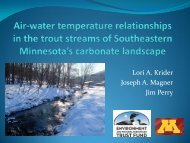Minnesota Water Resources Conference - Water Resources Center ...
Minnesota Water Resources Conference - Water Resources Center ...
Minnesota Water Resources Conference - Water Resources Center ...
Create successful ePaper yourself
Turn your PDF publications into a flip-book with our unique Google optimized e-Paper software.
BOOK OF ABSTRACTS<br />
Tuesday, Monday, October 27 23<br />
Poster Session 4:45–5:45<br />
<strong>Water</strong>: Recycle, Reuse, Protect the Environment, and Save Money<br />
Michael Jungbauer, Landform, mjungbauer@landform.net<br />
In an age of diminishing fresh water supplies, battles over water allocations, and increasing regulations on every<br />
aspect of water, practitioners need real tools and real information on available solutions. Business as usual will<br />
continue to drive us to the brink of impending water disasters as we’ve seen in other parts of the country.<br />
This presentation is focused on providing the tools necessary to start planning for the future, based on<br />
technological solutions that are proven and available today. A variety of solutions that are available for use in<br />
residential and commercial applications that can be applied to stormwater, wastewater, and lake restoration<br />
projects will be covered. The bio-chemistry associated with water problems is also discussed.<br />
Detailed topics include utilizing the existing hydrology and geology of a site in an effort to place treated water<br />
into rapid recharge areas to facilitate recharging the aquifers, as well as cities using intentional zoning to locate<br />
businesses such as car washes, laundromats, and greenhouses that can reuse recycled water.<br />
Technology is available today that is economical and is already being used on sites around the country. The goal<br />
of this presentation is to provide long term solutions that are available now and can be used to recycle, reuse,<br />
protect the environment, and save money.<br />
Development of Riverbank Stabilization Guidance for the Mississippi River<br />
Dan Kalmon, Mississippi <strong>Water</strong>shed Management Organization, dkalmon@mwmo.org; Jeremy Grush, LimnoTech; Hans<br />
Holmberg, LimnoTech; Todd Redder, LimnoTech; Todd Rexine, Great River Greening<br />
The Mississippi <strong>Water</strong>shed Management Organization (MWMO) is developing a riverbank classification<br />
system for the Mississippi River upstream of Ford Dam. Physical characteristics of the riverbank, along with<br />
predicted shear stresses across a full range of flows, will be used to classify and recommend bio-engineering<br />
applications to restore and protect the riverbanks. This presentation will describe the field survey and data<br />
collection, modeling, and data synthesis efforts being conducted to support this project. Field surveys are being<br />
conducted to collect information on bank profiles and slope, vegetative cover, soil type, and existing structures<br />
or protection measures. Two-dimensional hydrodynamic modeling of the Mississippi River from the Hwy 694<br />
bridge to Ford Dam has been conducted to assess shear stress and critical bank elevations. A data management<br />
and visualization tool is also being developed to allow property owners to select locations, review physical data<br />
and modeling results, and choose from applicable bio-engineering applications for their site.<br />
43 <strong>Minnesota</strong> <strong>Water</strong> <strong>Resources</strong> <strong>Conference</strong>, October 27–28, 2008
















